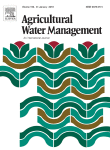Ver ítem
- xmlui.general.dspace_homeCentros Regionales y EEAsCentro Regional Mendoza - San JuanEEA JunínArtículos científicosxmlui.ArtifactBrowser.ItemViewer.trail
- Inicio
- Centros Regionales y EEAs
- Centro Regional Mendoza - San Juan
- EEA Junín
- Artículos científicos
- Ver ítem
Genotypic variation of physiological and morphological traits of seven olive cultivars under sustained and cyclic drought in Mendoza, Argentina
Resumen
The effects of two deficit irrigation regimes on the physiological, morphological, vegetative, and reproductive traits of seven olive cultivars were studied in a pot experiment. Specific leaf area (SLA) and SPAD chlorophyll meter reading (SCMR) were measured over the experimental period. Their relationships with physiological traits and with each other were also tested. Three-year-old plants in pots were subjected to control regime (CI replaced daily
[ver mas...]
The effects of two deficit irrigation regimes on the physiological, morphological, vegetative, and reproductive traits of seven olive cultivars were studied in a pot experiment. Specific leaf area (SLA) and SPAD chlorophyll meter reading (SCMR) were measured over the experimental period. Their relationships with physiological traits and with each other were also tested. Three-year-old plants in pots were subjected to control regime (CI replaced daily water use), sustained deficit regime (SDI was applied daily at 35% of CI), and five successive drought cycles of 30 days followed by rewatering (CDI). In all cultivars, SDI decreased stem water potential compared to CI. Under CDI, stem water potential reached the minimum, ∼–8 MPa, but all cultivars recovered to potentials similar to the rewatering period. Stomatal conductance was significantly reduced in both deficit irrigation regimes compared to the control. Rewatering caused a slower recovery of stomatal conductance in ‘Selección Mendoza’, ‘Villalonga’ and ‘Arbequina’ than in the rest of cultivars. Across cultivars, specific leaf area decreased with water deficit, while SCMR increased. Specific leaf area was positively related with stem water potential (R2 = 0.60), stomatal conductance (R2 = 0.44) and trunk growth (R2 = 0.31). In contrast, SCMR values were negatively related with stem water potential (R2 = 0.59), stomatal conductance (R2 = 0.52) and trunk growth (R2 = 0.62). ‘Changlot’, ‘Arauco’ and ‘Nevadillo Blanco’ cultivars maintained lower SLA and higher SCMR under both deficit irrigation regimes and higher stomatal conductance recovery after rewatering. These cultivars also appear to be better adapted to drought prone environments.
[Cerrar]

Autor
Trentacoste, Eduardo Rafael;
Contreras Zanessi, Octavio Ramiro;
Beyá-Marshall, Victor;
Puertas, Carlos Marcelo;
Fuente
Agricultural Water Management 196 : 48-56 (January 2018)
Fecha
2018-01-31
ISSN
0378-3774
Formato
pdf
Tipo de documento
artículo
Palabras Claves
Derechos de acceso
Restringido
 Excepto donde se diga explicitamente, este item se publica bajo la siguiente descripción: Creative Commons Attribution-NonCommercial-ShareAlike 2.5 Unported (CC BY-NC-SA 2.5)
Excepto donde se diga explicitamente, este item se publica bajo la siguiente descripción: Creative Commons Attribution-NonCommercial-ShareAlike 2.5 Unported (CC BY-NC-SA 2.5)

